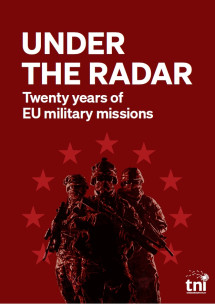New analysis of arms exports from the European Union to countries in conflict
A new analysis of arms exports from the European Union to countries in conflict or tension with refugees or internally displaced persons during the period 2003-2014 is now available.
EU member states have decided to authorize export licenses or effectively transfer arms to countries that have demonstrated a significant situation of vulnerability for the civilian population through indicators of instability and movements of populations.
The value of european arms authorizations and exports during the period of 2003-2014 totals 453,167,283,624 euros, of which at least 119,018,062,448 € of exports have been effectively carried out. The member states of the EU exported arms to 212 destinations, of which 89 have presented significant numbers of refugees or displaced persons and of which 65 are in conflict or unrest. A 29% of European arms exports from 2003 to 2014 (122 billion) were committed to places in conflict and/or tension, resulting in a total of 37.281 million euros in realized exports to these countries.
There have been arms exported from the member countries of the EU to countries in situations of conflict or tension where there are significant numbers of refugees and displaced persons. There are 39 countries whose unstable conditions and fluxes in population could indicate that these imported arms are being used in conflict, despite the implications that this might have for the country’s security. These countries make up 8.1% of the authorized recipients of exports and 9.2% of the importers of realized exports, or 36.714 billion euros and 10.9 billion euros respectively. Fifteen of these countries have experienced worsening conditions of security and another sixteen have conditions that have remained stagnant. Only eight countries have presented positive changes according to the indicators we have taken into account.
In 26 of the primary recipients of european arms with fluxes of refugees and displaced persons, the impact of arms imports is correlated with a negative evolution or perpetuation of conflict. These countries make up 7.4% of the authorized exports and 7.8% of realized exports, or 33.61 million euros and 9.32 million euros million respectively. These 26 countries have generated 75% of the refugees and displaced persons during this period (27.2 million people).
Another objective of the Report is to determine whether or not the authorized and realized EU arms exports are respecting the existing legislation on arms sales. The legislation referred to is the Common Position 2008/944 /CFSP of December 8th, 2008, which clarifies common parameters for arms exports, preventing from exporting them to places where they might be used for internal repression, international aggression, or where they could contribute to regional instability. European States are obligated to incorporate these criteria into their own national legislation while fully respecting the guidelines of the EU. However, the existence of refugees and displaced persons is an unequivocal indicator of an instability in the location. Arms can degrade violence situations from which displaced persons and refugees flee, worsening the circumstances in their home countries and impeding them from returning. The member states of the EU have access to this information and can use use it to make decisions about whether or not to approve licenses or to export arms to these countries. The Report therefore considers that the authorization of export licenses for defense, dual use, or any material considered to be an arm to destinations that have significant populations of refugee and displaced persons to be controversial and require a rigorous process of critical reflection at the state level before approval.
The Report, from the Delàs Centre for Peace Studies, can be downloaded from this website, It includes a great number of testable data to show that European arms exports have ended up in countries at war or in situations of grave insecurity. European arms exports have thus had the potential to worsen or perpetuate armed violence in these countries, preventing the lives of refugees or displaced persons from returning to normalcy.



